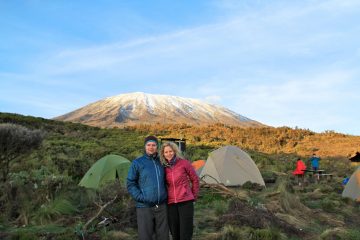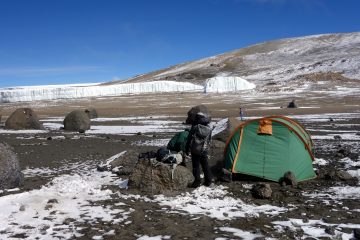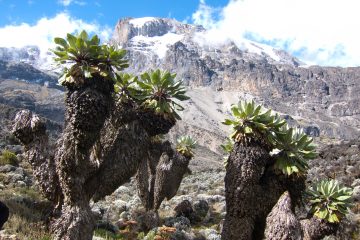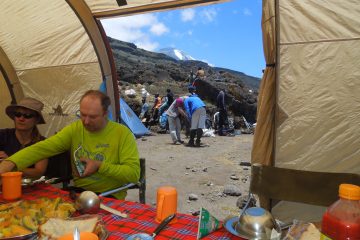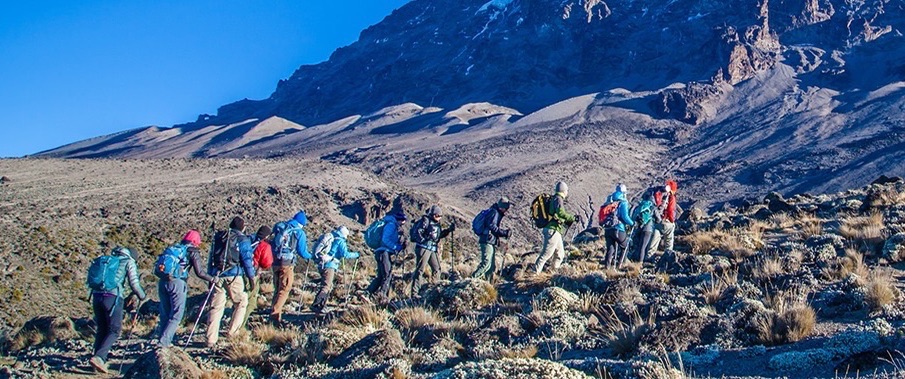Climbing Kilimanjaro in January
We recommend climbing Kilimanjaro after January 10th. The weather is warmer, and there is less rain and overcast clouds, comparing the month of January to other months, the summit can be a little bit crowded. This is one of the greatest months for Kilimanjaro climbing. We strongly advise visiting Tanzania in January. Remember that poor weather might strike at any time on the mountain, and storms from the Indian Ocean can arrive at any time.
About climbing Kilimanjaro on the new year in January
Climbing Kilimanjaro in February
February without a doubt one of the best months to climb Kilimanjaro. It’s possible to climb till the end of the month. On Kilimanjaro, February is warmer, with less cloud and better weather than the rest of the year. Warm weather brings sandy dry camps and trails, so being prepared for this is crucial. If the winds pick up, you’ll have dust in your clothes and potentially in your lungs. In warm weather, I recommend bringing a standard buff to wear during the day. We’ve seen groups caught in the tail end of a cyclone in February with severe winds on summit night, so be ready.
About climbing Kilimanjaro in January and February
Climbing Kilimanjaro in March
If you’re planning to climb Kilimanjaro in March, you should reconsider. The weather can be highly unpredictable on the mountain, it can rain or snow at any time. In March, clouds blanket Kilimanjaro, and the peak may not be visible from the valley for the whole month. Climbing Kilimanjaro in March may be more difficult due to slick rocks and damp gear that will be difficult to dry if the sun does not shine. Mountain views will be restricted, and snow is a distinct possibility further up above Barafu, at high camp 4,650 meters/15,255 ft. On the mountain, there will be fewer people.
Climbing Kilimanjaro in April
Only climb Kilimanjaro in April if you’re prepared to persevere in the mountain’s rainy weather. Alternatively, you could opt for the Rongai Route, which receives less precipitation since the trail runs through the northern slopes of the mountain. If the clouds clear, climbing Kilimanjaro in April may provide spectacular vistas. You risk not only thunder and lightning but also getting wet and not drying out for the whole of your vacation if it rains every day. April is smack in the heart of Kilimanjaro’s rainy season (March through May), and while it can rain on Kilimanjaro at any time of year, April may push you to your limits. The mountain will be less crowded in April, but the views will be poor, the rock will be damp, and the scenery on and off the mountain will be uninteresting.
About climbing Kilimanjaro in the rainy months of April
Climbing Kilimanjaro in May
We also frown upon climbing Kilimanjaro in May even though it has been drier than usual in recent years, but it is still one of the wettest months for climbing Kilimanjaro. We’ve had a mixed bag of experiences climbing Kilimanjaro in May, so we’ve chosen not to send groups up there in May for the previous few years. This month might be ideal for you if you don’t mind the rain and wish to climb with fewer people.
Climbing Kilimanjaro in June
From time to time, the rainy season will extend into early June. Higher up on the mountain, over 5,000 meters/16,400 feet, June can be a bit cooler. If you want to climb Kilimanjaro in June, expect dryer weather and fewer people than in February, August, or September. Depending on whose path you take up Kilimanjaro, it might be cold as early as the second night. The Lemosho trek is an 8-day hike that we suggest. You’ll get fantastic views of the mountain, sunrises, and sunsets if you climb in June. Sunsets are particularly beautiful in Shira Camp 2, Barranco Camp, and Karanga Camp. In June, we like to climb Kilimanjaro since there are fewer tourists than in July and August.
Climbing Kilimanjaro in July
There is a high probability that more people will climb Kilimanjaro in June. People climb around this time since it coincides with their holiday plans. Climbing Kilimanjaro in July is a fantastic idea. Because of the better circumstances, there will be more people on the mountain. Higher up, the temperature might be cooler, but this typically means better mountain vistas, less rain in the rainforest, and overall better mountain climbing conditions.
About climbing Kilimanjaro in July, August, September, October
Climbing Kilimanjaro in August
Another great month to climb Kilimanjaro. We usually recommend climbing Kilimanjaro using the Lemosho route for 8 days, therefore there will be fewer people at the start. When you meet up with the Machame route on day 3, their second day, you’ll see a lot more people. On the trails in August, it might be dry and dusty, so if the wind comes up, you’ll need to apply a light buff to keep dust off your face. This month has great weather and the mountain views are frequently not obstructed by clouds. August is one of the hottest months on the mountain. The Shira Plateau and Volcano are a little cooler on the western side of the mountain, but not enough to keep you from seeing them.
Climbing Kilimanjaro in September
September is also a lovely time to trek and easily one of our favorite months for climbing Mt. Kilimanjaro. The weather should be nice and pleasant above 5,000 meters/17,000 feet. In September, there may be fewer or more people on the mountain, but if you extend your acclimatization program (8 days), you will likely miss the summit. Climbing Kilimanjaro has a relatively low summit success rate, with approximately 50-60% of individuals making it to the top each year. September is one of the busier months for climbing Kilimanjaro, but the weather is pleasant, the conditions are dry, and the vistas are spectacular.
Climbing Kilimanjaro in October
Kilimanjaro is doable in October especially when you are climbing in early October. Higher up the mountain, it is warmer. Toward the end of October, there may be more cloud cover, keeping the sun off you but obstructing mountain views. Clear skies are more common in the morning, although clouds might come in early in the day, obstructing views of the peak. Climbing is best in early October. October is traditionally one of the best months to climb Kilimanjaro since the weather is typically relatively consistent.
Climbing Kilimanjaro in November
With increased chances of rain in November, climbing Kilimanjaro might be difficult. We avoid climbing Kilimanjaro in November due to the possibility of a mini-rainy season. In November, the mountain may see less steady weather patterns. As a result, rain might occur every day for a brief time. Poor mountain vistas, less visibility, and more snow higher in the mountains can all have an influence on your journey. If the weather is clear and the snow is falling, the views from further up will rival any mountain sight. Remember, snow may fall at any time of year over 5,000 meters/16,400 feet on the mountain.
Climbing Kilimanjaro in December
Climbing Mount Kilimanjaro in December is a possibility. At the beginning of December and over the Christmas season until early January, an increasing number of tourists climb Kilimanjaro. Each December, we offer three climbs on Kilimanjaro to accommodate the Christmas holidays. On the mountain, we believe this is a favorable weather time. It varies from year to year and is less consistent than the months we’ve mentioned.
Read about celebrating Christmas on Kilimanjaro mountain in December






